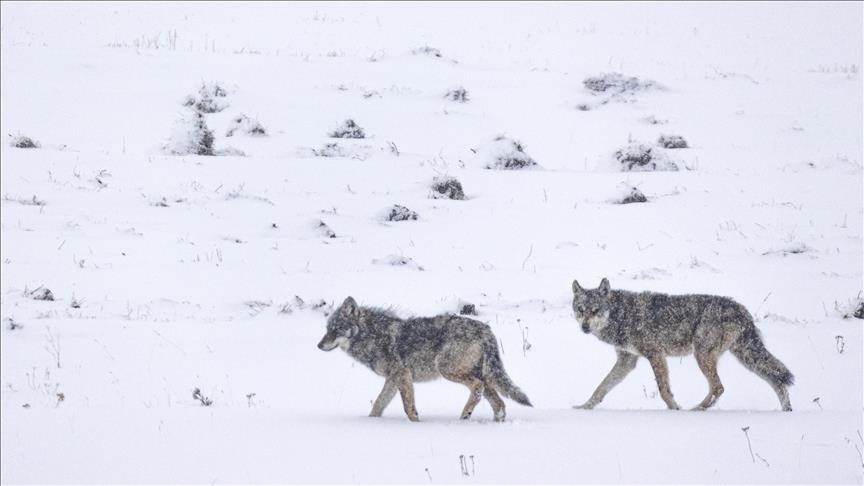EXPLAINER - Wolves in Europe: Why EU suddenly favors culls over protective measures?
EU's decision to lower protection status of wolves sparks debate among conservationists, policymakers, and rural communities

- Some favor bloc's move pointing to 'growing challenges faced by farmers,' while others reckon decision 'driven by political pressures'
- In interview with Anadolu, experts warn move may undo 'years of successful conservation'
GENEVA
The EU's decision to lower the protection status of wolves has sparked a significant debate among conservationists, policymakers, and rural communities.
A recent move by the EU Commission, alongside the Bern Convention, to allow more flexibility in managing wolf populations—potentially including culling—has drawn sharp criticism from environmental groups.
These changes aim to address concerns about livestock predation but raise questions about the long-term consequences for wolf populations and European biodiversity.
The EU Commission's controversial proposal is rooted in the claim that it would allow member states to take more control over managing wolves, especially to protect livestock. However, this proposal has drawn widespread concern from conservationists and environmental groups.
The World Wildlife Fund (WWF) and the European Environmental Bureau (EEB) have both condemned the decision, describing it as politically driven and lacking scientific justification.
In an interview with Anadolu, Sabien Leemans, a senior policy officer at WWF, expressed deep concern about the potential consequences for Europe’s ecosystems.
"Wolf populations are recovering across Europe, and this is actually a remarkable conservation success … but this process is still ongoing.
Only three of Europe’s nine wolf populations are classified as ‘Least Concern’ on the International Union for Conservation of Nature (IUCN) Red List of Threatened Species, Leemans said, adding: “The wolf populations are not fully recovered yet.”
Sergiy Moroz, a senior policy officer at the European Environmental Bureau (EEB), echoed these concerns, calling the decision "regrettable" and emphasizing the absence of updated scientific assessments in a separate interview with Anadolu.
This decision sends the "wrong message," shifting the emphasis from coexistence to hunting, Moroz warned.
Political pressure behind decision
Both conservationists pointed to political motivations behind the EU’s decision. Leemans alleged that the move may have been influenced by European Commission President Ursula von der Leyen, while Moroz attributed it to pressures from the conservative bloc in the European Parliament seeking to appeal to rural voters ahead of elections.
"The only thing that did change was politics," Moroz said. "It's true we are having some impact on livestock, but it's minor. It's absolutely minor, and there is compensation in place.”
He was referring to the EU report that states only 0.065% of livestock is affected by wolf attacks annually with “minor impact.”
He argued that the bloc’s decision sacrifices long-term biodiversity goals for short-term electoral gains by using wolves as a tool to “whip up fear and hysteria.”
Leemans, regarding the figure of 0.065%, said the problem generally seems “very small.”
“But of course, we must understand that at the individual level, for a farmer, the impact can be very big, and actually, there are countries that have good systems in place to compensate farmers when this happens, … but not in all countries this is well developed,” she said.
She highlighted the inconsistency in the EU’s approach, noting that a 2022 proposal by Switzerland to lower wolf protection was rejected by the EU on scientific grounds.
Using the same data, the EU has made a complete turnaround, she said, explaining: “At the time, the EU and all EU member states voted against the proposal because they were saying, there are no reasons; there is no scientific data to argue in favor of such a proposal. Without the situation changing dramatically in two years … they propose now to lower the protection status of the wolf.”
“This was a politically-motivated decision," she said.
Both experts also warned that the decision could have far-reaching consequences beyond wolves.
Wolves, as apex predators, play a crucial role in maintaining ecosystem balance, from reducing overgrazing to curbing the spread of diseases like tuberculosis in livestock, Leemans underlined.
Moroz emphasized that the decision risks tarnishing the EU’s global credibility as a leader in biodiversity.
"The EU often urges other countries to preserve biodiversity and coexist with large predators. Yet, at home, it appears to be abandoning these principles," he said.
Leemans voiced similar concerns, fearing that the decision could weaken the EU’s Habitats Directive, potentially affecting other species like brown bears and lynxes.
“Given the past track records of bad implementation of the habitat directive, we think in many countries, this will lead to more shooting and hunting of wolves, although the population does not allow for it, and so we fear that it might lead to decreasing populations of wolves in Europe,” she said.
She lamented: “Europe is not basing its conservation policies on science anymore.”
Farmers urge stabilization of wolf population
In stark contrast, the Swiss Farmers' Union (SFU) praised the EU’s decision, citing increasing challenges in protecting livestock from wolf attacks.
"We believe the easing of restrictions is right. Here in Switzerland, the wolf is spreading exponentially, so it is a long way from extinction," said the union spokesperson Sandra Helfenstein.
Switzerland experiences between 1,000 and 1,500 wolf attacks on livestock annually, with protective measures proving costly and difficult, particularly in mountainous regions, Helfenstein added.
“It is now very costly to fend off the attacks with protective measures,” she said. “We have areas in the Alps that can no longer be used as pastures today because the safety of the animals can no longer be guaranteed.”
She noted that fencing is particularly challenging in the Alps, and herd protection dogs have their limits when wolves are a constant presence.
While the SFU does not advocate for eradicating wolves, it calls for stabilizing their population to prevent further strain on rural economies, according to the spokesperson.
"It’s not black and white. We don’t want to eradicate the wolf; we want to stabilize the population," Helfenstein said, adding that unchecked wolves disrupt the balance of prey species like deer and stags.
Coexistence
Leemans and Moroz stressed the importance of coexistence measures over hunting. They pointed to effective strategies like electric fences, guard dogs, and enclosures, supported by EU funding, as the best ways to prevent livestock attacks.
Wolves are often “scapegoated” for broader rural challenges, Leemans said, adding that blaming wolves won’t solve these issues.
“Of course, there are many problems for farmers, and they need a lot of support, for instance, to transition to more sustainable farming practices, and only blaming the wolf for all the problems is not going to bring the real change and the real solutions that farmer communities also need in Europe,” she said.
Moroz underscored that existing coexistence measures are already working. The focus should be on education, prevention, and creating opportunities for rural economies, not on fearmongering and unscientific decisions, he said.
Both experts urged the EU to reconsider the decision and wait for updated conservation data in 2025 before making drastic changes.
"If you want to look at this (issue), wait then until the new data comes in, and then we can see if there are big changes,” Leemans said.
Moroz called for prioritizing science and sustainability. "It isn’t about exterminating wolves again. It’s about learning to live with them," he said.
Both experts underlined that taking out problematic animals is “already possible” under the current protection of the wolves, showing it as another reason why lowering protection is unnecessary.
“This whole debate and framing and going for lowering of the protection status distracts it from the real solutions that we should be doing,” Moroz said. “We've spent last year arguing about this rather than really arguing how we should what we really should be doing with those prevention measures and how we should be paying for them.”
The EU is expected to formalize the decision in March 2025, with potential amendments to the Habitats Directive likely to follow.
According to the WWF, for the moment, there are around 23,000 wolves in Europe - divided into nine populations, and only three of them are least concerned, meaning they are really out of danger. One population is vulnerable, and the others are near threatened.
Anadolu Agency website contains only a portion of the news stories offered to subscribers in the AA News Broadcasting System (HAS), and in summarized form. Please contact us for subscription options.







